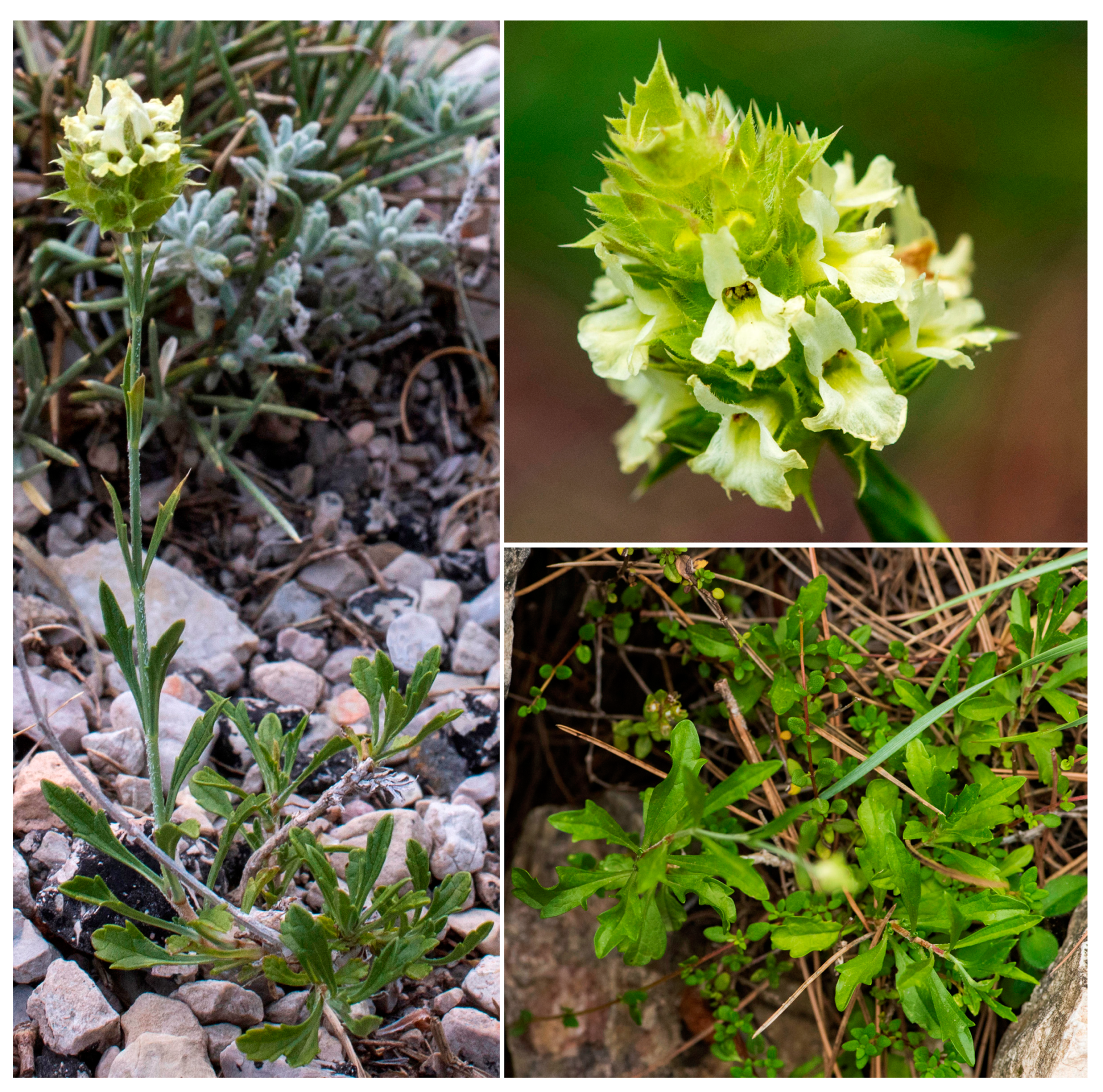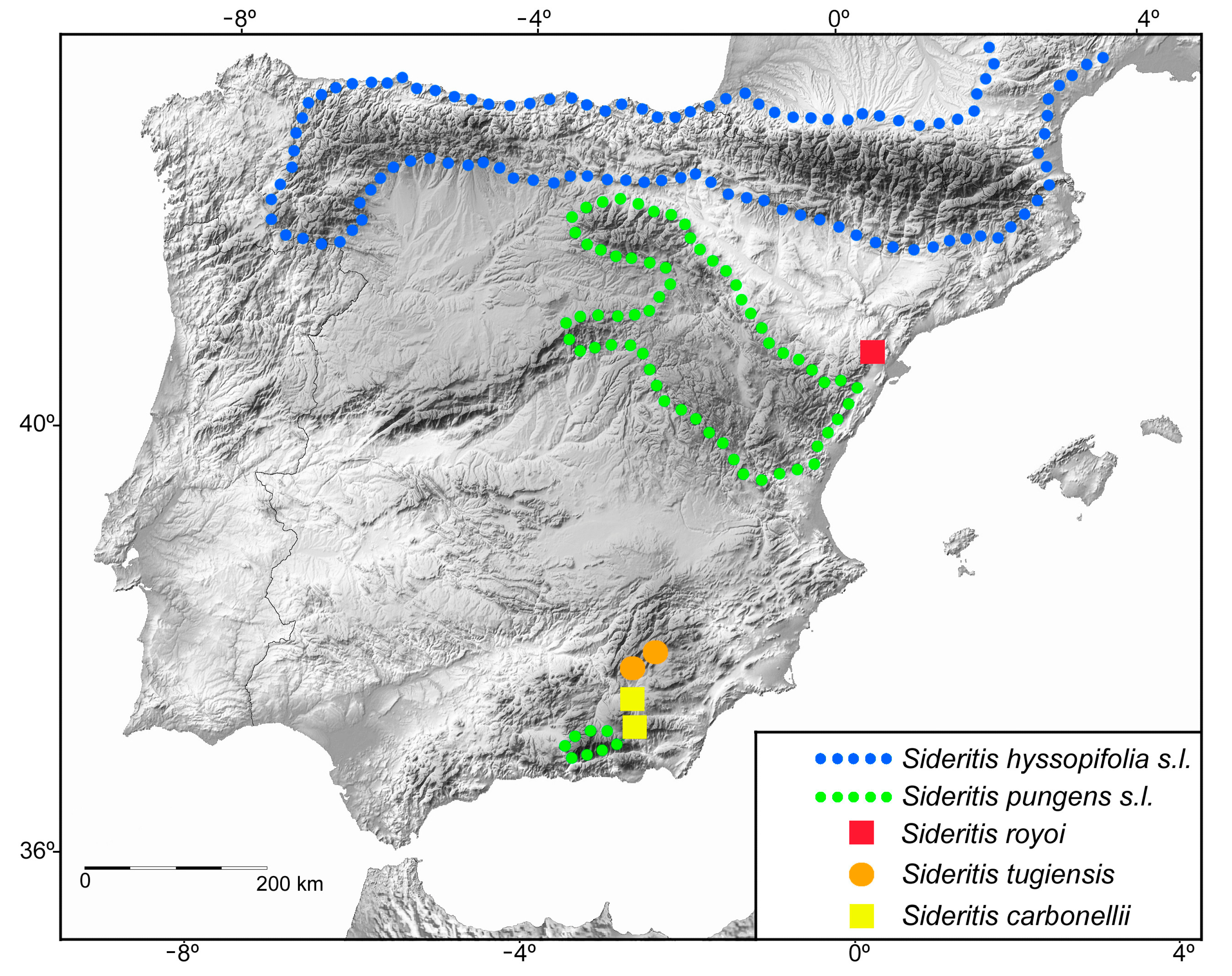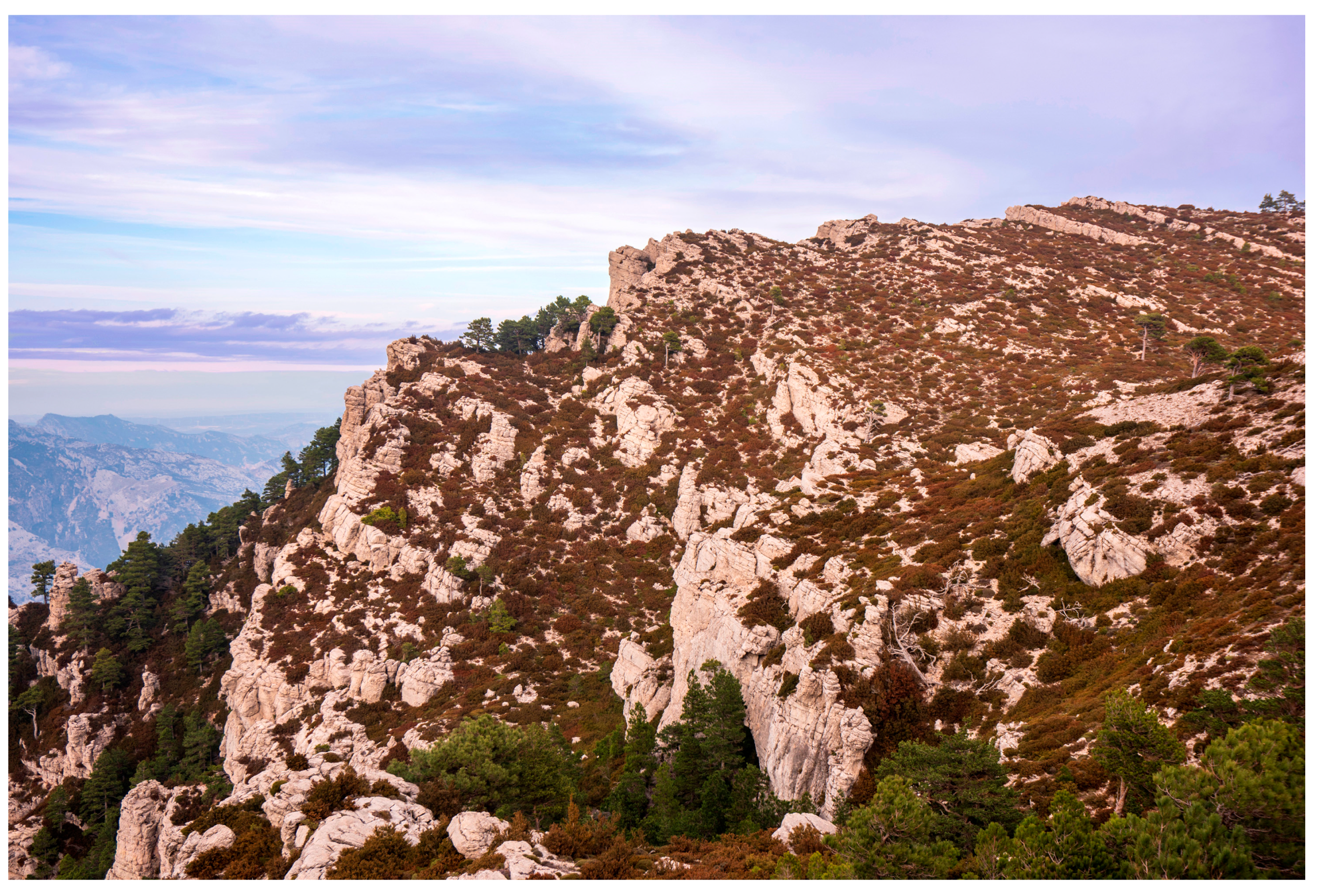Sideritis royoi (Lamiaceae): A New Orophilous Species from Northeastern Spain †
Abstract
1. Introduction
2. Materials and Methods
3. Results
Taxonomic Treatment
4. Discussion
5. Identification Key for Sideritis subsect. Hyssopifoliae
- 1 .
- Calyces with carpostegium continuous …………………………………………………………………………………………………………….….2
- 1′.
- Calyces with carpostegium discontinuous ……………………………………………………………………………………………………………7
- 2 .
- Central part of verticillasters 2–10 mm apart …………………………………………………………………………………………………………3
- 2′.
- Central part of verticillasters 15–35 mm apart ………………………………………………………………………………………………………11
- 3 .
- Inflorescence axis without glands ………………………………………………………………………………………………………………………4
- 3′.
- Inflorescence axis with glands ………………………………………………………………………………………………………………………….5
- 4 .
- Base of branchlets with glands, trichomes 0.3–0.7 mm long; inflorescence axis trichomes 0.2–0.4(–1) mm long ……………… S. getula Batt.
- 4′.
- Base of branchlets without glands, trichomes 0.5–2.0 mm long; inflorescence axis trichomes 0.8–1.5 mm long ………… S. hyssopifolia (s.l.)
- 5 .
- Leaves without glands; lower bracts 5–7 × 8–10 mm, with 2–4 teeth on each side; corollas 6–7 mm long ………………… S. maura de Noé
- 5′.
- Leaves with glands; lower bracts 7–12 × 5–12 mm, with 3-8 teeth on each side; corollas 8–10 mm long ……………………………………6
- 6 .
- Middle bracts 7–12 mm; calyx teeth 3 mm long, trichomes 0.6–1.3 mm long …………………………………………………… S. pungens (s.l.)
- 6′.
- Middle bracts 5–6 mm; calyx teeth 1–2 mm long, trichomes 2 mm long ……………………………………… S. algarviensis D. Rivera & Obón
- 7 .
- Branchlets with glands at base …………………………………………………………………………………………………………………………8
- 7′.
- Branchlets without glands at base ……………………………………………………………………………………………………………………10
- 8 .
- Base of branchlets goniotrichous to holotrichous, covered with hairs 0.8–1.5 mm ……………………………………………… S. pungens (s.l.)
- 8′.
- Base of branchlets holotrichous, covered with very short hairs up to 0.8 mm ………………………………………………………………… 9
- 9 .
- Lower leaves entire, 10–25 × 1–1.5 mm, axillary fascicles absent at flowering time; uppermost leaves similar to the lower, entire; calyx with scarce trichomes ……………………………………………………………………………………………………………………… S. carbonellii
- 9′.
- Lower leaves dentate, 12–17 × 2–3 mm, axillary fascicles commonly present at flowering time; uppermost leaves bract-like, with 0–4 teeth on each side; calyx with abundant trichomes ……………………………………………………………………………………………… S. tugiensis
- 10.
- Main surfaces of the leaves with eglandular hairs; upper leaves non subspinescent; main abaxial surface of the bracts hairy; inflorescences with (1–)2–13 verticillasters ……………………………………………………………………………………… S. hyssopifolia (s.l.)
- 10′.
- Main surfaces of the leaves glabrous or glabrescent; upper leaves subspinescent; main abaxial surface of the bracts without eglandular hairs; inflorescences with 1–2(–3) verticillasters …………………………………………………………………………………………. S. royoi
- 11.
- Leaves without glands; lower bracts 6–8 × 3–6 mm, middle bracts 4–5 × 7–8 mm ………………………………………… S. ochroleuca Willk.
- 11′.
- Leaves with glands; lower bracts (8–)10–17 × 3–9(–10) mm, middle bracts 7–10 × 8–10 mm ……………………………… S. hyssopifolia (s.l.)
Author Contributions
Funding
Institutional Review Board Statement
Informed Consent Statement
Data Availability Statement
Acknowledgments
Conflicts of Interest
Appendix A. Representative Specimens
References
- Obón, C.; Rivera, D. A Taxonomic Revision of Section Sideritis, Genus Sideritis (Labiatae); J. Cramer: Berlin, Germany, 1994; 640p. [Google Scholar]
- Rivera, D.; Obón, C. Study of the biogeography and centres of diversity in section Sideritis (genus Sideritis, Labiatae). Lagascalia 1997, 19, 865–872. [Google Scholar]
- Harley, R.M.; Atkins, S.; Budantsev, A.L.; Cantino, P.D.; Conn, B.J.; Grayer, R.; Harley, M.M.; De Kok, R.; Krestovskaja, T.; Morales, R.; et al. Labiatae. In The Families and Genera of Vascular Plants. Flowering Plants. Dicotyledons: Lamiales (except Acanthaceae including Avicenniaceae); Kadereit, J.W., Kubitzki, K., Eds.; Springer: Berlin/Heidelberg, Germany, 2004; Volume 7, pp. 167–275. [Google Scholar]
- Mabberley, D.J. The Plant Book: A Portable Dictionary of the Vascular Plants, 2nd ed.; Cambridge University Press: Cambridge, UK, 1997; 858p. [Google Scholar]
- Sáez, L.; Aymerich, P.; Blanché, C. Llibre Vermell de les Plantes Vasculars Endèmiques i Amenaçades de Catalunya; Argania Editio: Barcelona, Spain, 2010; 811p. [Google Scholar]
- Torres, L. Flora del Massís del Port; Publicacions de la Diputació de Tarragona: Tarragona, Spain, 1989; 463p. [Google Scholar]
- Buira, A.; Balada, R.; Mesa, D.; Álvarez, J.M.; Arrufat, M.; Beltran, J.; Cardero, S.; Curto, R.; Royo, F.; Torres, L.; et al. Noves contribucions al coneixement de la flora vascular del massís del Port (NE de la península Ibèrica). Orsis 2009, 24, 117–140. [Google Scholar]
- Sáez, L.; Aymerich, P. An Annotated Checklist of the Vascular Plants of Catalonia (Northeastern Iberian Peninsula); Kit-book Serveis Editorials: Barcelona, Spain, 2021; 717p. [Google Scholar]
- Rivera, D.; Obón, C.; Tomás-Lorente, F.; Ferreres, F.; Tomás Barberán, F. Infrasectional systematics of the genus Sideritis L. section Sideritis (Lamiaceae). Bot. J. Linn. Soc. 1990, 103, 325–349. [Google Scholar]
- Rivera, D.; Obón, C.; Alcaraz, F.; Llorach, R. Systematics of the high mountain taxa of the genus Sideritis L., section Sideritis, subsection Fruticulosa Obón & D. Rivera (Lamiaceae). Bot. J. Linn. Soc. 1999, 129, 249–265. [Google Scholar]
- Ríos, S.; Crespo, M.B.; Rivera, D. The west Mediterranean orophilous taxa of Sideritis L. (Lamiaceae): A new species of subsection Hyssopifolia from south-eastern Spain. Bot. J. Linn. Soc. 2001, 136, 247–254. [Google Scholar] [CrossRef][Green Version]
- IPNI. The International Plant Names Index. The Royal Botanic Gardens, Kew, Harvard University Herbaria & Libraries and Australian National Herbarium. 2023. Available online: http://www.ipni.org (accessed on 22 February 2023).
- Thiers, B. Index Herbariorum: A Global Directory of Public Herbaria and Associated Staff. New York Botanical Garden’s Virtual Herbarium. 2023. Available online: https://sweetgum.nybg.org/science/ih/ (accessed on 14 July 2023).
- Rivas-Martínez, S. Avances en Geobotánica; Real Academia Nacional de Farmacia: Madrid, España, 2005; 128p. [Google Scholar]
- Rivas-Martínez, S. Mapa de series, geoseries y permaseries de vegetación de España (Memoria del Mapa de vegetación potencial de España). Parte I. Itinera Geobotanica 2007, 17, 5–435. [Google Scholar]
- IUCN. IUCN Red List Categories and Criteria: Version 3.1; IUCN Species Survival Commission: Gland, Switzerland; Cambridge, UK, 2012; 32p. [Google Scholar]
- IUCN. IUCN Guidelines for Using the IUCN Red List Categories and Criteria: Version 15.1; Standards and Petitions Subcommittee: Gland, Switzerland; Cambridge, UK, 2022; 114p. [Google Scholar]
- Morales, R. Sideritis L. In Flora iberica. Verbenaceae-Labiatae-Callitrichaceae; Morales, R., Quintanar, A., Cabezas, F., Pujadas, A.J., Cirujano, S., Eds.; Real Jardín Botánico de Madrid (C.S.I.C.): Madrid, Spain, 2010; Volume 12, pp. 234–288. [Google Scholar]
- Font Quer, P. Contribució al coneixement de la flora catalana occidental. Treb. Mus. Ci. Nat. Barcelona 1920, 5, 193–233. [Google Scholar]
- Malagarriga, T. Font Quer y el nombre de las plantas sennenianas. Collect. Bot. 1968, 7, 677–695. [Google Scholar]
- Socorro, O.; Arrebola, M.L. Nuevas combinacions en el género Sideritis L. (Lamiaceae) para la flora ibero-norteafricana. Lagascalia 1994, 17, 356–357. [Google Scholar]
- López-Udias, S. Estudio taxonómico de Sideritis javalambrensis Pau (Magnoliopsida, Labiatae), patrimonio natural exclusivo de la provincia de Teruel. Teruel 2020, 95–96, 161–215. [Google Scholar]
- Heywood, V.H. Sideritis L. In Flora Europaea; Tutin, T.G., Burges, N.A., Chater, A.O., Edmondson, J.R., Heywood, V.H., Moore, D.M., Valentine, D.H., Walters, S.M., Webb, D.A., Eds.; Cambridge University Press: Cambridge, UK, 1972; Volume 3, pp. 138–143. [Google Scholar]
- Rivera, D.; Obón, C. Estudio de la hibridaci6n entre Sideritis incana var. edetana Pau ex Font Quer y S. angustifolia Lag. Monogr. Inst. Piren. Ecol. 1988, 4, 325–332. [Google Scholar]
- Rivera, D.; Obón, C. Hybridization between Sideritis serrata Lag. and Sideritis bourgaeana Boiss. (Lamiaceae) in their hybrid zone in Spain. Ann. Bot. 1990, 66, 147–154. [Google Scholar]
- Obón, C.; Rivera, D.; Alcaraz, F.; De la Torre, A. Nuevos híbridos del género Sideritis (Labiatae) en la Península Ibérica. Anales Jard. Bot. Madrid 1996, 54, 295–299. [Google Scholar]
- Roselló, R.; Ferrer-Gallego, P.P.; Guillén, A.; Riera, J.; Gómez, J.; Laguna, E.; Peris, J.B. Sobre la variabilidad infraespecífica de Sideritis fruticulosa Pourr. (Labiatae). Flora Montiber. 2018, 72, 39–60. [Google Scholar]
- Bolòs, O.; Vigo, J. Flora dels Països Catalans; Editorial Barcino: Barcelona, Spain, 1996; Volume 3, 1230p. [Google Scholar]
- Bolòs, O.; Vigo, J.; Masalles, R.M.; Ninot, J.M. Flora Manual dels Països Catalans, 3rd ed.; Editorial Pòrtic: Barcelona, Spain, 2005; 1310p. [Google Scholar]




| Character | S. royoi | S. hyssopifolia | S. pungens | S. tugiensis | S. carbonellii |
|---|---|---|---|---|---|
| Arrangement of hair covering at base of branchlets | Goniotrichous | Holotrichous to Goniotrichous | Goniotrichous to holotrichous | Holotrichous | Holotrichous |
| Base of branchlets: hair length (mm) | 0.2–1.0 | 0.2–1.9(–2.0) | 0.2–1.5 | (0.2–)0.4–0.8 | (0.4–)0.6(–0.8) |
| Lower leaves: size (mm) | 6–32 × 3–12 | 7–50 × 2–11 | 8–50 × 2–4 | 12–17 × 2–3 | 10–25 × 1–1.5 |
| Lower leaves: shape | Subspatulate to sublinear | Spatulate to lanceolate | Linear | Oblanceolate | Linear |
| Lower leaves: margin | Dentate | Entire to serrate | Entire | Dentate | Entire |
| Lower leaves: density of trichomes at main surface | Glabrous or almost glabrous | Scarce | Scarce | Scarce | Scarce to very scarce |
| Lower leaves: arrangement of trichomes at margin | Clearly distinct when present | Clearly distinct | Clearly distinct | Indistinct, except in the basal of leaves | Clearly distinct |
| Uppermost leaves | Narrower than the lower leaves, subspinescent | Similar to the lower | Similar to the lower or narrower leaves | Bract-like, with 0–4 teeth | Similar to the lower leaves, exceptionally with 1 tooth |
| Axillary fascicles during flowering time | Usually absent | Occasionally present | Occasionally present | Very frequent | Absent |
| Number of verticillasters | 1–2(–3) | (1–)2–13 | 3–12 | 1–2(–4) | 1–3(–5) |
| Distance of internode in central verticillasters (mm) | 2–3.5 | 2–12 | 3–7 | 3–6 | 5–6 |
| Shape of the inflorescence | Ovoid or globose | Cylindrical to globose | Cylindrical | Ovoid or globose | Ovoid or globose |
| Inflorescence length (cm) | 0.7–2.5(–4) | 0.8–12 | 1–7 | 0.7–2.5 | 0.5–1.5(–2) |
| Inflorescence axis: density of glands | Absent | Absent | Very scarce | Very abundant | Absent |
| Lower bract size (mm) | 7–9 × 6–10 | 4–17 × 3–12 | 7–12 × 9–12 | 4.5–5.5 × 6–8 | 5–6 × 4–7 |
| Teeth on each side of the lower bracts | 3–8 | 0–8(–9) | 4–7 | 2–4(–5) | 2–3(–5) |
| Lower bracts: greatest width | 1/3 above the base | 1/5–1/2 above the base | 1/8–1/3 above the base | 1/3 above the base | 1/2 above the base |
| Middle bracts size (mm) | 8–10 × 9–12 | 3–11 × 6–11 | 6–12 × 8–13 | 4–5 × 6–7 | 4–5 × 5–6 |
| Number of teeth on each side of middle bracts | 6–10 | 3–8(–9) | 4–8 | 3–6 | 2–3(–5) |
| Abaxial surface of middle bracts: hairiness | Glabrous | Hairy | Hairy | Glabrous | Glabrous |
| Middle bracts: hair length (mm) | – | 0.8–1.5 | 0.1–0.5 | 0.2–0.7 | 0.3–0.5 |
| Calyx length (mm) | 8–11 | (5–)6–10(–11) | 7–8 | 6–7 | 7–8 |
| Calyx: density of glands | Scarce | Scarce or absent | Scarce | Abundant | Scarce or abundant |
| Calyx: density of trichomes | Scarce | Scarce | Very scarce | Abundant | Scarce |
| Calyx: length of hairs (mm) | 0.5–1.8 | 1–2.2 | 0.6–1.3 | 0.5–1.5 | 0.9–1.1 |
| Corolla length (mm) | 6–9 | 6–12 | 7–9 | 8–9 | 7–10 |
| Corolla: upper lip | Emarginate | Entire to emarginate | Emarginate or notched | Bifid | Emarginate or notched |
| Style length (mm) | 1.8–2.5 | 2–4 | 2–5 | 3–3.1 | 1.8–2.2 |
Disclaimer/Publisher’s Note: The statements, opinions and data contained in all publications are solely those of the individual author(s) and contributor(s) and not of MDPI and/or the editor(s). MDPI and/or the editor(s) disclaim responsibility for any injury to people or property resulting from any ideas, methods, instructions or products referred to in the content. |
© 2024 by the authors. Licensee MDPI, Basel, Switzerland. This article is an open access article distributed under the terms and conditions of the Creative Commons Attribution (CC BY) license (https://creativecommons.org/licenses/by/4.0/).
Share and Cite
Sáez, L.; Curto, R.; Crespo, M.B. Sideritis royoi (Lamiaceae): A New Orophilous Species from Northeastern Spain. Taxonomy 2024, 4, 112-125. https://doi.org/10.3390/taxonomy4010006
Sáez L, Curto R, Crespo MB. Sideritis royoi (Lamiaceae): A New Orophilous Species from Northeastern Spain. Taxonomy. 2024; 4(1):112-125. https://doi.org/10.3390/taxonomy4010006
Chicago/Turabian StyleSáez, Llorenç, Rafel Curto, and Manuel B. Crespo. 2024. "Sideritis royoi (Lamiaceae): A New Orophilous Species from Northeastern Spain" Taxonomy 4, no. 1: 112-125. https://doi.org/10.3390/taxonomy4010006
APA StyleSáez, L., Curto, R., & Crespo, M. B. (2024). Sideritis royoi (Lamiaceae): A New Orophilous Species from Northeastern Spain. Taxonomy, 4(1), 112-125. https://doi.org/10.3390/taxonomy4010006







